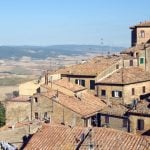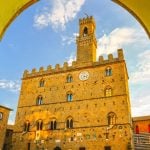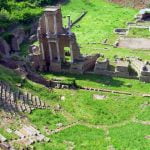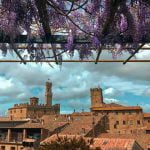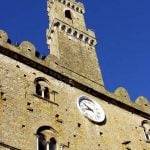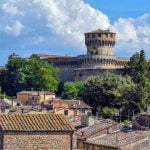The historical and walled city of Volterra is located in Italy’s picturesque Tuscany region. This town is steeped in ancient history that can be traced back for thousands of years. It emanates an enchanting Italian quality as one wanders the cobblestone streets that wind around the town showcasing structures that can be traced back to the Middle Ages. This small town is one of the best kept secrets of Tuscany and a must for any Italian vacation itinerary with off-the-beaten-path destinations.
Part of the charm of this sleepy town is its remoteness. While it is one of the more popular smaller Tuscan towns for travelers to visit and has a strong tourism industry, it is not crowded with tourists the way Florence or Rome are. The city is still home to many residents who work and live here as their families have for centuries before them.
Volterra is one of the oldest cities in the Italian region of Tuscany. It is estimated to have once been a Bronze Age settlement that was later developed and inhabited by the Etruscans. Eventually the town came under Roman rule, evidence of which can still be seen in some of the local architecture. Volterra flourished during the Middle Ages and Renaissance period. Afterwards, the town was under the rule of the Republic of Florence before ultimately becoming part of Italy as we know it today. Volterra is thought to have been continuously inhabited since circa the eighth century BC.
Volterra’s cuisine is marked largely by agricultural specialties such as extra virgin olive oil, truffles, chestnuts, and grapes for wine. These crops are the basis of many of the city’s most frequently requested dishes. In addition to these items, wild boar and locally made cheeses are a favorite for diners.
Because of the small and communal nature of many of Volterra’s neighboring villages, it is not unusual for the residents of those areas to come to the city for certain services such as education, shopping, and more.
If an Italian getaway is taking you to the gorgeous town of Volterra and you are flying in, your best bet may be the Florence or Pisa international airports. The city is approximately an hour and 20 minutes away from the Florence airport via local highways and roadways and roughly an hour away from the Pisa airport. For those travelers already in Italy and headed to Volterra, it is possible to reach the town by car.
While locals will likely tell travelers there is no bad time to visit Volterra, the city typically experiences the highest number of visitors in the spring and early summer. Early fall can also be part of the main travel season. However, many seasoned travelers say that November is one of their favorite months to visit as the weather is still reasonable and there is far less tourist traffic.
When it comes to seeing the sights inside of the city of Volterra, it may be prudent to plan to travel by foot or bicycle. Much of the center and heart of the city is closed off to public traffic and requires visitors to park outside the city in designated parking areas. With the quaint and charming beauty of this part of Italy, walking the city at leisure is one of the best ways to engage with local culture.
Volterra is a town of rich culture and history, much of which can be found in the area’s architecture and museums. As you travel the town and the piazze to immerse in the local culture, be sure to visit the religious institutions of the Volterra Cathedral of Santa Maria Assunta and the Volterra Baptistery of San Giovanni as well as the Etruscan city walls and the Etruscan Museum.
Perhaps the only thing to rival Volterra’s beauty is its fascinating history that spans millennia. Consider exploring the city courtesy of a private walking tour to learn more about this amazing place as well as the traditions and customs it still observes today.
GEOGRAPHY
The city of Volterra is a rather small town located on the western side of Italy within the province of Pisa and the region of Tuscany. Although the city is surrounded by protective walls, many residents also live just outside the walls.
The town of Volterra is a maze of winding cobblestone streets, many of which can be steep in nature. The town is filled with modern day cafés, restaurants, and shops. Although Volterra is small, many of the nearby rural villages and communities are even smaller, making Volterra a frequent day trip to town for basic services.
CLIMATE
The summer climate in Volterra is seasonal with warm summers of temperatures around 80 degrees Fahrenheit and lows closer to 60 degrees. July is usually the warmest month of the year.
The fall months begin a slow decline in highs and lows ending in November with highs typically in the 50s and lows in the 40s.
The winter months bring cooler temperatures with averages in the 40s and lows just above freezing. January is typically considered to be the coldest month of the year in Volterra.
Although the weather can vary depending on the season, most travelers consider the city’s temperatures to be conducive to sightseeing almost year-round.
ONLY IN VOLTERRA
When traveling to Volterra, be sure to visit one of the many stores selling alabaster products. This town is known for its ancient alabaster mines, many of which are still operational today. Alabaster is a very fine, translucent and white form of the mineral gypsum that is often used in sculpting.
Visitors should plan to take a leisurely stroll down the cobblestone streets and tour several of the stores. Here travelers will find stunning handmade alabaster plates, bowls, vases, and more. These alabaster treasures make fantastic souvenirs for loved ones and excellent Italian showpieces for your own home.
If the art of alabaster intrigues you, don’t miss a tour of the Alabaster Museum which features hundreds of artistic examples of this mineral.
Located in the heart of Tuscany, the town of Volterra enchants with its historic architecture and rich past. Enjoy a long stroll through Volterra’s center as you learn about the town’s famous alabaster tradition and perhaps purchase a unique souvenir that will always remind you of your time in this special part of Italy.
Travel Guides
[wudrelated include="1837"]
The Tuscany Region of Italy
[wudrelated include="1839"]
The Cities of Tuscany, Italy
[wudrelated include="4236"]
